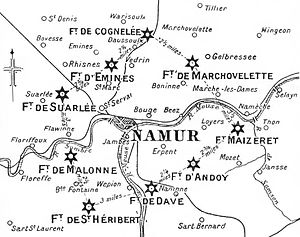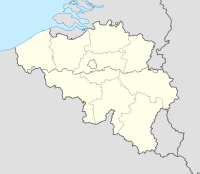
Back Namurun mühasirəsi (1914) Azerbaijani Siège de Namur (1914) French Նամյուրի պաշարում (1914) Armenian Assedio di Namur (1914) Italian 나뮈르 공성전 Korean Cerco de Namur Portuguese Осада Намюра (1914) Russian Cuộc vây hãm Namur (1914) Vietnamese
| Siege of Namur | |||||||
|---|---|---|---|---|---|---|---|
| Part of the Western Front of the First World War | |||||||
 Map of the city and Fortified Position of Namur | |||||||
| |||||||
| Belligerents | |||||||
|
|
| ||||||
| Commanders and leaders | |||||||
|
|
| ||||||
| Strength | |||||||
| 107,000 | 35,000 | ||||||
| Casualties and losses | |||||||
| 300 killed, 600 wounded or missing |
c. 15,000 (including 6,700 POW) | ||||||
Namur in the Arrondissement of Namur, Belgium | |||||||
The siege of Namur (French: siège de Namur) was a battle between Belgian and German forces around the fortified city of Namur during the First World War. Namur was defended by a ring of modern fortresses, known as the Fortified Position of Namur and guarded by the 4th Division of the Belgian Army. The purpose of the fortified Belgian cities was to delay an invasion force until troops from the states guaranteeing Belgian independence came to their aid. The French Fifth Army planned to counter-attack while the Germans were besieging Namur.
The German 2nd Army arrived in force on 20 August 1914 and used the experience gained from the Battle of Liège (4–16 August). The Germans did not attempt a coup de main but waited until the next day and bombarded the forts using super-heavy siege artillery and four batteries on loan from Austria-Hungary. The forts were destroyed by the bombardment, some being demolished by conventional heavy artillery rather than the siege guns, due to flaws in the concrete protection encasing the forts. In contrast to Liège, the Germans reduced the forts while suffering very few casualties.
The defeat of the Fifth Army at the Battle of Charleroi on 21 August prevented the French from advancing further and only one regiment reached Namur as reinforcement. As it became clear that additional relief forces would not arrive, on 23 August survivors of the Belgian 4th Division withdrew southwards to join the Fifth Army near Saint-Gérard. The last of the Namur forts surrendered on 25 August. The 4th Division troops eventually joined the Belgian field army at Antwerp during its siege.
